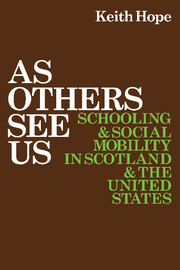Book contents
- Frontmatter
- Contents
- Acknowledgments
- Introduction
- 1 Scotland: A meritelective system?
- 2 Comparison of Scotland with England and Wales
- 3 Comparison of Scotland with the United States
- 4 IQ + effort = merit
- 5 The institutions of managed meritelection
- 6 Was selection carried out fairly?
- 7 Meanings of key terms
- 8 Does deprivation affect life chances?
- 9 Market situation
- 10 Intelligence and occupational mobility
- 11 Intelligence and vertical mobility
- 12 Scottish society
- 13 Understanding other people's norms
- 14 Merit or desert?
- Notes
- References
- Index
3 - Comparison of Scotland with the United States
Published online by Cambridge University Press: 05 February 2012
- Frontmatter
- Contents
- Acknowledgments
- Introduction
- 1 Scotland: A meritelective system?
- 2 Comparison of Scotland with England and Wales
- 3 Comparison of Scotland with the United States
- 4 IQ + effort = merit
- 5 The institutions of managed meritelection
- 6 Was selection carried out fairly?
- 7 Meanings of key terms
- 8 Does deprivation affect life chances?
- 9 Market situation
- 10 Intelligence and occupational mobility
- 11 Intelligence and vertical mobility
- 12 Scottish society
- 13 Understanding other people's norms
- 14 Merit or desert?
- Notes
- References
- Index
Summary
So far, we have compared Scotland with the United States in order to get a sense of just how meritelective the Scottish system was, and we have attempted to compare Scotland with England and Wales, although with only limited success. Before leaving the realm of comparison in order to concentrate on the analysis of Scotland, we will carry out one more comparison, again with the United States. The American data are those reported by O. D. Duncan in his paper, “Ability and achievement.”
Basis of analysis and results
In his analysis Duncan (1968a) incorporated information from a group intelligence test, and whereas we have employed individually tested IQs in the preceding Scottish analyses, we will now switch to the group test results which are also available. On June 4, 1947, the Scottish researchers administered a group test, which they called V (which stands for “verbal”) to all children in Scottish schools (including almost all private schools) who were born in 1936, and so we have V scores for the members of our sample.
Duncan's analysis is reproduced in Figure 3.1, and its Scottish analogue is given in Figure 3.2. Duncan's path diagram includes income as its ultimate variable. This has been omitted here because no income data are available for the Scots. Number of siblings in the Scottish analysis is the number recorded in 1964 and so is comparable with the same variable in the American analysis.
- Type
- Chapter
- Information
- As Others See UsSchooling and Social Mobility in Scotland and the United States, pp. 46 - 62Publisher: Cambridge University PressPrint publication year: 1985
- 1
- Cited by



